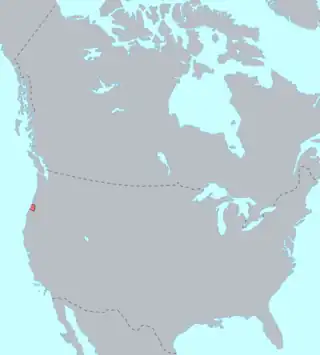Siuslaw language
Siuslaw /saɪˈjuːslɔː/[2] was the language of the Siuslaw people and Lower Umpqua (Kuitsh) people of Oregon. It is also known as Lower Umpqua[lower-alpha 1]. The Siuslaw language had two dialects: Siuslaw proper (Šaayušƛa) and Lower Umpqua (Quuiič).[3]
| Siuslaw | |
|---|---|
| Lower Umpqua | |
| Šáayušƛa / Qúuiič | |
| Pronunciation | /saɪˈjuːslɔː/ |
| Native to | United States |
| Region | Oregon |
| Ethnicity | Siuslaw people |
| Extinct | 1960[1] |
Coast Oregon Penutian?
| |
| Language codes | |
| ISO 639-3 | sis |
| Glottolog | sius1254 |
| ELP | Siuslaw |
 Pre-contact distribution of Siuslaw | |
Classification
Siuslaw is currently considered to be a language isolate.[4] It may be part of a Coast Oregon Penutian family together with Alsea and the Coosan languages, although the validity of this family is still controversial. Proponents of the disputed Penutian phylum usually include Siuslaw as part of it, together with the other Coast Oregon Penutian languages.[5]
Documentation
Published sources are by Leo J. Frachtenberg who collected data from a non-English-speaking native speaker of the Lower Umpqua dialect and her Alsean husband (who spoke it as a second language) during three months of fieldwork in 1911,[6][3][7] and by Dell Hymes who worked with four Siuslaw speakers in 1954.[8]
Further archived documentation consists of a 12-page vocabulary by James Owen Dorsey,[9] a wordlist of approximately 150 words taken by Melville Jacobs in 1935 in work with Lower Umpqua speaker Hank Johnson,[10] an audio recording of Siuslaw speaker Spencer Scott from 1941, hundreds of pages of notes from John Peabody Harrington in 1942 based on interviews with several native speakers,[11] and audio recordings of vocabulary by Morris Swadesh in 1953.
Phonology
Consonants
| Labial | Alveolar | Lateral | Palatal | Velar | Glottal | |
|---|---|---|---|---|---|---|
| Stop | p | t | k | ʔ | ||
| Affricate | ts | tɬ | tʃ | |||
| Fricative | s | ɬ | ʃ | x | h | |
| Nasal | m | n | ||||
| Approximant | w | l | j |
Cluster of stops/affricates + glottal stop are realized as ejective consonants [pʼ tʼ tɬʼ tsʼ tʃʼ kʼ].
Vowels
Vowels are noted as /i æ a u ə o/.[8]
Notes
- Upper Umpqua (or simply Umpqua) was an Athabaskan language and thus unrelated to Siuslaw/Lower Umpqua.
References
- Grant, A.P. (1997). "Coast Oregon Penutian: Problems and Possibilities". International Journal of American Linguistics. 63 (1): 144–156. doi:10.1086/466316. S2CID 143822361. Retrieved 7 February 2021.
- "Frequently Asked Questions". United States Forest Service. Retrieved May 12, 2020.
- Frachtenberg, Leo Joachim; Franz Boas; Smithsonian Institution. Bureau of American Ethnology (1917). Siuslawan (Lower Umpqua): an illustrative sketch. Govt. Printing Office. Retrieved 28 August 2012.
- Campbell, Lyle (January 2019). "How many Language Families are there in the world?". International Journal of Basque Linguistics and Philology. 1 (2): 133–152. doi:10.1387/asju.20195. Retrieved 2021-02-24.
- Grant, A. (1997). Coast Oregon Penutian: Problems and Possibilities. International Journal of American Linguistics, 63(1), 144-156.
- Frachtenberg, Leo. (1914). Lower Umpqua texts and notes on the Kusan dialect. In Columbia University contributions to Anthropology (Vol. 4, pp. 151–150).
- Frachtenberg, Leo. (1922). Siuslawan (Lower Umpqua). In Handbook of American Indian languages (Vol. 2, pp. 431–629).
- Hymes, Dell. (1966). Some points of Siuslaw phonology. International Journal of American Linguistics, 32, 328-342.
- Dorsey, James Owen. (1884). [Siuslaw vocabulary, with sketch map showing villages, and incomplete key giving village names October 27, 1884]. Smithsonian Institution National Anthropological Archives.
- Melville Jacobs papers, 1918-1978, University of Washington Special Collections, Seattle WA.
- Harrington, John P. 1942. "Alsea, SIuslaw, Coos, Southwest Oregon Athapaskan: Vocabularies, Linguistic Notes, Ethnographic and Historical Notes." John Peabody Harrington Papers, Alaska/Northwest Coast. National Anthropological Archives, Smithsonian Institution, Washington, DC.